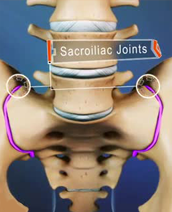Sacroiliac Joint Disease
 There are many different terms for sacroiliac joint problems, including SI joint dysfunction, SI joint syndrome, SI joint strain, and SI joint inflammation. Each of these terms refers to a condition that causes pain in the SI joints from a specific cause.
There are many different terms for sacroiliac joint problems, including SI joint dysfunction, SI joint syndrome, SI joint strain, and SI joint inflammation. Each of these terms refers to a condition that causes pain in the SI joints from a specific cause.
What are the causes of sacroiliac joint dysfunction?
As with most other joints in the body, the SI joints have a cartilage layer covering the bone. The cartilage allows for some movement and acts as a shock absorber between the bones. When this cartilage is damaged or worn away, the bones begin to rub on each other, and degenerative arthritis (osteoarthritis) occurs.
Another common cause of SI joint dysfunction is pregnancy. During pregnancy, hormones are released in the woman’s body that allows ligaments to relax. This prepares the body for childbirth. Relaxation of the ligaments holding the SI joints together allows for increased motion in the joints and can lead to increased stresses and abnormal wear.
Any condition that alters the normal walking pattern places increased stress on the SI joints. This could include a leg length discrepancy (one leg longer than the other), or pain in the hip, knee, ankle, or foot. Patients with severe pain in the lower extremity often develop problems with either the lower back (lumbar spine) or SI joints. Usually, if the underlying problem is treated, the associated lumbar spine or SI joint dysfunction will also improve.
There are many disorders that affect the joints of the body that can also cause inflammation in the SI joints. These include gout, rheumatoid arthritis, psoriatic arthritis, reactive arthritis, and ankylosing spondylitis. These are all various forms of arthritis that can affect all joints. Ankylosing spondylitis is an inflammatory arthritis that always affects the SI joints. It can lead to stiffness and severe pain in the SI joints, due to inflammation in the sacroiliac joints (sacroiliitis). As the disease process continues, the SI joints can fuse together and have no range of motion. Once this occurs, there is no further pain associated with the SI joints. Rarely, bacterial infection can involve the sacroiliac joints.

